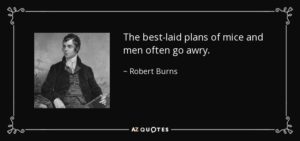My Sunday morning peruse of Twitter led me to a blog post ‘Agile Project Manager’, It’s a Contradiction. Despite being a little taken aback, I did click through and read it. And I whole-heartedly disagree!
I’m going to start my response by first looking at some definitions.
Methodology – Merriam-Webster defined it as “a particular procedure or set of procedures.”
Waterfall – Wikipedia defined it as “a sequential (non-iterative) design process, used in software development processes, in which progress is seen as flowing steadily downwards (like a waterfall) through the phases.”
Agile – Wikipedia defined it as “a set of principles for software development under which requirements and solutions evolve through the collaborative effort of self-organizing cross-functional teams.”
Process – Merriam-Webster defined it as “a series of actions or operations conducing to an end.”
Principles – Merriam-Webster defined it as “a rule or code of conduct.”
In project management, both Agile and Waterfall are considered project management “methodologies” used to deliver projects. They provide a set of guiding principles for getting results, and delivering business value. They both have pros and cons, and each is not right in every situation. Many times, a hybrid approach is needed.
Regardless of approach, a good project manager needs to be incredibly flexible. They need to understand the dynamics of all stakeholders, grasp the complexities of the value proposition and manage the situation throughout the process, adapting to the changing landscape. I would argue that even when using a waterfall methodology, a good project manager must be nimble.
It saddens me that the author of the aforementioned blog post feels that project managers “belong purely to highly planned deliveries where any change is a hinderance and fluidity is frowned upon.” Have they not ever worked with a good project manager that adapted to the movement of the project? Or have I just been incredibly lucky to work in organizations that allowed me to adapt and morph the project, and my role within in it as I see fit? It didn’t matter whether I was using a waterfall approach or were working towards agile.
The author further states that an agile project manager is a hybrid role, comprised of multiple responsibilities on projects not large enough to all the prescribed roles. I prefer to work within small to mid-size organizations, however usually work on projects for very large organizations. I’ve not had the luxury on any project to have a person to fill every role. Additionally, I think there is some level of getting your hands dirty in analysis, value recognition and other aspects of the project that enable me to delivery the projects I work on.
The one area where we did agree is “The ability to adapt, morph and practically deliver is…the true spirit of agile delivery.” I would also argue that it is the true spirit of a good project manager. If we are not constantly assessing where we are against our goals, and making decisions about how we manage the project (across stakeholders), and making adjustments to our plans, we can’t be successful.
